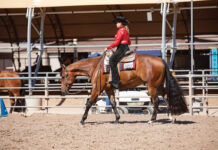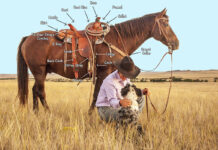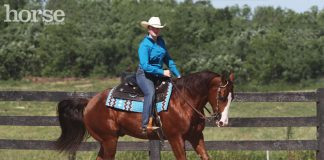It’s mesmerizing to see your horse float across a field, his limbs swinging effortlessly like pendulums. While a horse is built to cover ground, he often loses that long flowing stride with a rider on his back. We often restrict our horse’s range of motion, intentionally or inadvertently. Sometimes it’s because we want him to perform a job that requires him a slow step or because we feel anxious and hold him back. One problem with not encouraging your horse to access full range of motion under saddle, is that he misses out on all the benefits.
- Gives him a break from slow work.
- Conditions him for collected work.
- Improves joint flexibility.
- Strengthens his topline.
- Encourages relaxation.
- Increases stride depth.
- Improves his balance.
- Stretches his muscles.
- Develops suppleness.
- Improves transitions.
- Develops smoother gaits.
- Builds stamina.
Completely short-strided training sessions can create tension and lead to muscle soreness over time. Constantly confining your horse’s movement can also have a negative effect on his attitude. Varied stride length is essential for a well-rounded athlete and a happier horse.
Once thing a longer stride doesn’t mean, though, is a faster pace. The rhythm of your horse’s gait should remain the same. The only change is that he takes a bigger step. This distinction is important, because speed is a sign that your horse has lost his balance and is no longer benefitting from the exercise.
To cue your horse to lengthen his stride, stretch tall through your spine and draw your shoulders slightly behind the vertical. This will add a small amount of weight to your horse’s hindquarters and encourage him to reach farther under his body with his hind legs. It also reduces weight on his forehand and so his front legs can swing freely.
Move your hands forward by pushing your elbows in front of your body. Hold the reins softly in your hands, following the natural motion of your horse’s head and neck to avoid shutting down your horse’s forward momentum. Be prepared to adjust your rein length and your horse stretches out, lengthening the reins to maintain light contact as your horse extends his neck and elongates his spine.
If your horse needs further encouragement to move out, apply rhythmic pressure with your calves or gently nudge him with your heels. If your horse shows some reluctance to stride forward, he may feel insecure about taking a bigger step that he’s used to. A soft and supple feel of your horse’s mouth will give him the support and courage that he needs. Gentle rein contact is also useful if your horse has trouble staying straight or if his gaits feel wobbly.
Extended gaits require a higher level of effort from your horse, so introduce them slowly. Ask him to lengthen his stride in stages over a period of time to reduce the risk of muscle or joint soreness or strain. Gradually working up to fully lengthened gaits as your horse builds strength, flexibility, and endurance.





